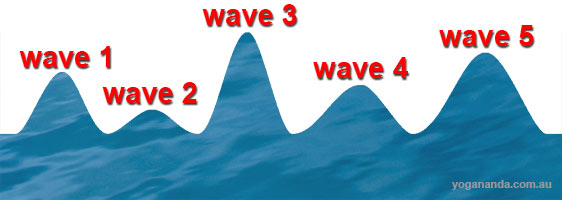Theory of Maya
Excerpts from writings by
Paramahansa Yogananda and Swami Vivekananda
Projection & Concealment
Maya (from the Sanskrit root ma, "to measure") divides, measures out, the Undefined Infinite into finite forms and forces. Maya functions through its two powers: the power of projection and power of concealment.
Maya
projects
names (knowledge)
on Nature & others
and
Maya conceal
from us Brahman,
the fundamental oneness of everything and
everyone in the universe
Maya generally indicates the illusion, both cosmic and individual where we project names (knowledge) on Nature and others.
Maya also conceal from us Brahman, the fundamental oneness of everything and everyone in the universe. Maya hides the true nature of God.
It is due to maya that one sees a snake in place of rope, water in the desert, and multiplicity in place of oneness. "The Reality (Truth) is one: the wise call It by various names."
The soul's consciousness is veiled or narrowed. The wholeness is veiled in order that the part or specific may be experienced.
Maya is that which seemingly makes the Whole (Purana) into the not whole (Apurna), the infinite into the finite, the formless into forms and the like.
Maya divides the united consciousness so that the object is seen as other than the self and then as split up into the multitudinous objects of the universe.
![]()
Spirit alone is perfect. Everything in creation, being delimited, is imperfect. The very beginning of creation gave rise to the law of duality—light and darkness, good and evil—the law of relativity necessary to divide the One into the many. By the storm of vibration, God's thoughts of multiplicity brought forth the waves of manifestation: His lila, or divine play. (sc)
![]()
Objects in the phenomenal world
are called relative because they exist only
in relation to each other.
Man's ordinary consciousness is relativity consciousness —i.e., he apprehends one thing only by interpreting it relative to something else. He cannot perceive the One, the Absolute, through that relative consciousness; it was given to him in order to appreciate the nature of the many. Ordinary waking consciousness, subconsciousness, super-subconsciousness—all forms of ego consciousness—share this characteristic: they are relative. The pure superconsciousness of the soul can apprehend Spirit, the Life and Substance underlying and pervading everything in the universe. (bg)

This theory of Maya has been the most difficult thing to understand in all ages. Let me tell you in a few words that it is surely no theory, it is the combination of the three ideas Desha-Kâla-Nimitta — space, time, and causation — and this time and space and cause have been further reduced into Nâma-Rupa. Suppose there is a wave in the ocean.

The wave is distinct from the ocean only in its form and name, and this form and this name cannot have any separate existence from the wave; they exist only with the wave. The wave may subside, but the same amount of water remains, even if the name and form that were on the wave vanish for ever. (sv III:419)

The Upanishads on Maya
The Upanishads declare that the universe is only maya.
Brahman,
the Absolute,
became the Universe through
Time,
Space and
Causation
(law of cause and effect).
And then there is the law of duality and relativity: light cannot exist without darkness, good without evil, up without down, warm without cold etc.
The Universe is
Transitory
Changing
Perishable
In our lives
we only encounter
the projections of our own minds.
The science tells us that outside us there are only energies of different frequencies and that our brains assemble them into pictures and our minds give them names and meanings.

Only Name and Form
So this Maya is what makes the difference between me and you, between all animals and man, between gods and men. In fact, it is this Maya that causes the Atman to be caught, as it were, in so many millions of beings, and these are distinguishable only through name and form.

If you leave it alone, let name and form go, all this variety vanishes for ever, and you are what you really are. This is Maya. (sv III:420)
Everything here in the sense-world is dependent and interdependent, relative and correlative, the existence of one depending on the other. There are three steps, therefore, in our knowledge of things;
1. Each thing is
individual and separate from every other
2. There is
a relation and correlation between all things;
3. There is only one thing which we see as many.
(a) The Absolute
↓
(c) Time / Space / Causation
↓
(b) The Universe
Here is the Absolute (a), and this is the universe (b). The Absolute has become the universe. By this is not only meant the material world, but the mental world, the spiritual world — heavens and earths, and in fact, everything that exists. Mind is the name of a change, and body the name of another change, and so on, and all these changes compose our universe.
This Absolute (a)
has become
the universe (b)
by coming through time, space, and causation (c).
This is the central idea of Advaita.Time, space, and causation are like the glass through which the Absolute is seen, and when It is seen on the lower side, It appears as the universe.
Now we at once gather from this that in the Absolute there is neither time, space, nor causation. The idea of time cannot be there, seeing that there is no mind, no thought. The idea of space cannot be there, seeing that there is no external change. What you call motion and causation cannot exist where there is only One. We have to understand this, and impress it on our minds, that what we call causation begins after, if we may be permitted to say so, the degeneration of the Absolute into the phenomenal, and not before; that our will, our desire and all these things always come after that. (sv III:420)
* sv = Complete Works of Swami Vivekananda
![]()